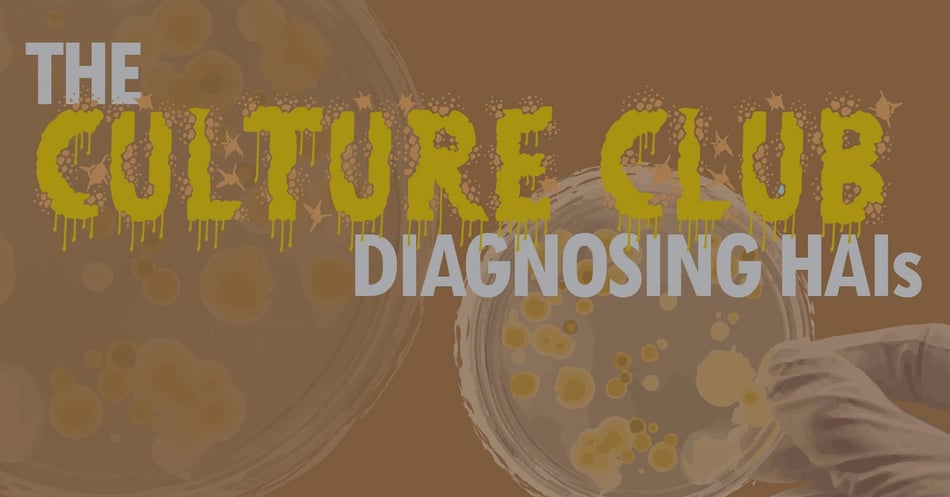The Culture Club: Diagnosing HAIs

 How do healthcare providers arrive at an HAI diagnosis? A CDC-mandated timing protocol determines whether a patient's infection is healthcare-associated or not. However, it is through a combination of clinical findings, diagnostic testing, and response to treatment that a medical team will determine the presence of an infection in the first place. Today's post will provide a very general overview of the steps a medical team may take in order to diagnose an HAI.
How do healthcare providers arrive at an HAI diagnosis? A CDC-mandated timing protocol determines whether a patient's infection is healthcare-associated or not. However, it is through a combination of clinical findings, diagnostic testing, and response to treatment that a medical team will determine the presence of an infection in the first place. Today's post will provide a very general overview of the steps a medical team may take in order to diagnose an HAI.
Clinical Findings
Healthcare providers are always on the lookout for symptoms that may indicate an infection. They check body temperature, incision sites, ventilator tubes, catheter output, heart rate, oxygen levels, and every other possible source of information for any hints of infection. Once an infection is suspected, samples must taken and sent to the laboratory for testing.
Types of Samples
Depending on the location of the suspected infection, different samples will be taken. Pneumonia, located in the lung, requires samples of phlegm that have not been contaminated by saliva or a ventilator component. To confirm a bloodstream infection, blood samples from the vein and from the bloodstream catheter are taken. Catheter-associated urinary tract infections require testing urine directly from the bladder. Gastrointestinal infections are diagnosed using stool samples, while surgical site infections often use tissue samples.
Laboratory Tests: Culturing and Staining
Once the correct sample is in the lab, a variety of methods are used to reveal whether pathogenic bacteria are present. One type of test involves culturing the sample for bacteria. To culture bacteria, the sample is placed in a medium that promotes growth in the bacteria - the right temperature, enough nutrition, etc. After a set period of time, the growth medium is examined under a microscope to see if colonies have formed. If bacteria are present, the next step may involve gram staining or acid-fast staining, during which a dye is added to the bacteria. Depending on whether or not the bacteria absorbs the dye and changes color, the physician will be able to determine if the bacteria is gram negative or gram positive. The answer will help determine what antibiotic to use.
Laboratory Tests: Antigens and Antibodies
An infection can be diagnosed by directly measuring the pathogen, but it can also be detected by testing for effects of that pathogen. Bacteria have surface proteins called antigens that our body detects as foreign material that must be attacked. If our immune system is responding as it should, once these antigens are detected, our body will release antibodies to seek out those antigens, bond with them, and destroy the bacteria cell. This process leaves chemical markers in our blood that can be picked up by a variety of laboratory tests that use dye to attach to antibodies or antigens. Along these same lines, there are tests that identify the toxins release by specific pathogens, such as C. difficile.
Laboratory Tests: Genetic Material and PCR Testing
Today's technological advances allow physicians to test samples for bacteria at the genomic - or DNA - level. These tests use advanced genetic sequencing to identify markers for specific pathogens. Polymerase Chain Reaction (PCR) testing is particularly helpful, since it enables a lab to create an enormous number of identical DNA segments that can then be used to identify a pathogen. PCR testing is extremely helpful when the pathogen is a slow-growing culture (such as tuberculosis), since any delay to treatment can be dangerous to the patient. Multiplex PCR is a new technology that allows for multiple strands of DNA from a variety of sources to be copied, allowing a doctor to identify one pathogen from a sample with many types of bacteria present (such as a stool sample).
Today's post merely touches on the incredible work done by laboratories in support of the medical teams treating patients. This work is often unsung, unseen, and underappreciated. (Just watch a medical TV show to see how thankless the job of lab technician can be!) However, it is the painstaking work of these individuals that helps determine treatment, alerts doctors to possible outbreaks, and provides the data that can help identify a possible source of contamination. We hope to explore more about this essential hospital department in future posts.
Editor's Note: This post was originally published in November 2017 and has been updated for freshness, accuracy and comprehensiveness.
![EOScu Logo - Dark - Outlined [07182023]-01](https://blog.eoscu.com/hubfs/Eoscu_June2024/Images/EOScu%20Logo%20-%20Dark%20-%20Outlined%20%5B07182023%5D-01.svg)




